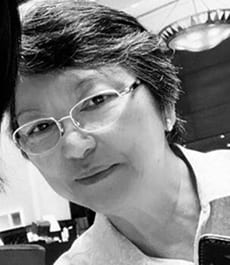Maria Luisa C. SADORRA
Yvonne LOONG, The Chinese University of Hong Kong
From the perspectives of a teacher and a coordinator, Luisa and Yvonne share their first remote teaching collaboration. Their hope? That their experience reaches out to colleagues who are overcoming their reservations about virtual teaching.

Photo used with permission from the Independent Learning Centre, Chinese University of Hong Kong
Luisa, the Teacher (January/March 2020)
It was the second time I was invited to conduct a two-hour workshop on thesis oral defence (viva) for 35 postgraduate students who were to do their viva soon. My host university coordinator (Yvonne) at The Chinese University of Hong Kong (CUHK) scheduled the workshop for late April 2020. I designed the workshop around the concepts of scholarship and persona, which translate to having these students view their viva as their first “expert” presentation that will seal their membership in the discipline(s). Students were expected to gain an understanding of the content and structure of their viva as well as the kinds of responses to panel questions, and to design their viva persona. With these goals, the workshop was titled Designing a Successful Oral Defence. I had finished my preparation when Yvonne alerted me in March 2020 that with the Covid-19 situation, the university had shifted all their teaching-learning from face-to-face to Zoom, and so I was to retreat to the safety of my home (Philippines) to conduct an online workshop.
Yvonne, the Administrator (March/April 2020)
Conducting an engaging Zoom session myself is challenging enough, let alone having one with a guest speaker Zooming from the Philippines, a Library colleague in her office, and me from home (Hong Kong). As the coordinator, I first had to help Luisa familiarise herself with teaching via Zoom—as we all know, meeting our friends/relatives via Zoom is one thing, teaching via Zoom is a completely different endeavour. It was more difficult than I thought; one reason being I was using a PC and Luisa, a Mac. Following that were discussions on major issues such as which Zoom features would work well with the activities prepared by Luisa, given our understanding of the university culture and student characteristics within the workshop duration, and seemingly trivial ones such as whether we would need to have a break in the middle of the session. Luisa and I also practised a few times to ensure we know when we need to ‘start share’ and ‘stop share’, when we need to share the handouts using OneDrive via Chat, and when we should introduce the available university resources to reinforce the points made.

Virtual background used with permission from Culiat, J. (2015). Boston- old and new. Retrieved from https://www.facebook.com/photo.php?fbid=10207163176903549&set=pb.1406335697.-2207520000..&type=3&theater
Luisa (April 2020)
Although Zooming my workshop seemingly challenged how I could generate student engagement, Yvonne’s abiding administrative assistance supported my shift to successful online workshopping. I reframed my PowerPoint slides within the virtual reality environment of my workshop.
Sensitive to CUHK’s university culture and the class profile, I wove in the idea of cultural continuity (Holliday, 2001) by situating new knowledge (e.g., social judgment theory, kinds of response to panel questions, viva persona) in the disciplinary viva conventions of the university and student expectations.
Alerted to the fact that less can be achieved with the same amount of time, I decided to have some pre-workshop tasks for students which helped them make connections with their prior knowledge, eventually leading to integration that generated development of insight and understanding (Puchta, 2013).
I was mindful of sufficient teacher and student talk if I were to achieve student engagement, so I rehearsed a definitive exposition, and considered possible divergent and probing questions at specific junctures of the lesson (Walsh, 2011).
Finally, I recorded my voice a few times to hear for myself and ensure that it was conversational yet modulated, natural, and vigorously persuasive. Zoom, after all, was refashioning my teacher persona.
Yvonne and Luisa (May 2020)
So, was all the preparation worth it? Did our plan work well? We can confidently say “YES”, given the questions raised by students in the Q & A, their comments via Chat throughout the session, and the extremely positive feedback in the post-workshop survey. Students commented that “the content and material were useful and relevant”. Many of them found the “explanations and presentation clear and helpful”. However, we must admit that we are very fortunate to also have had back up from the CUHK Library (co-organiser) and that despite the surging global internet traffic, there was neither slowdown nor breakdown of the internet.
 |
Maria Luisa C. SADORRA is a language consultant and independent researcher. Her teaching experience includes 35 years of teaching courses in language and communication [CELC, NUS and De La Salle University-Manila (DLSU-Manila)], reading instruction and research (graduate) at DLSU-Manila, and persona studies at the NUS Residential Colleges Luisa can be reached at lecturer.praise5@gmail.com. |
 |
Yvonne LOONG is a Senior Lecturer at The Independent Learning Centre at The Chinese University of Hong Kong (CUHK). She’s also a Senior Fellow of the Higher Education Academy, UK. Prior to joining CUHK, Yvonne worked at, among others, the University of Hong Kong and the National University of Singapore. She has been involved in teaching research postgraduates topics such as “Thesis Writing”, “Research Methods” and “Vocabulary Teaching and Learning”. Her research interests include English for academic/specific purposes, writer identity, and independent learning. Yvonne can be reached at loongycw@cuhk.edu.hk. |
References
Holliday, A. (2001). Achieving cultural continuity in curriculum innovation. In D. R. Hall & A. Hewings (Eds.), Innovations in English Language Teaching: A Reader (pp. 169-177). London: Routledge.
Puchta, H. (2013). Engaging adult learners: What ELT can learn from neuroscience and educational theory. In J. Arnold & T. Murphey. Meaningful action: Earl Stevick’s influence on language teaching (pp. 45-61). Cambridge: Cambridge University Press.
Walsh, S. (2011). Exploring classroom discourse: Language in action. London: Routledge.

